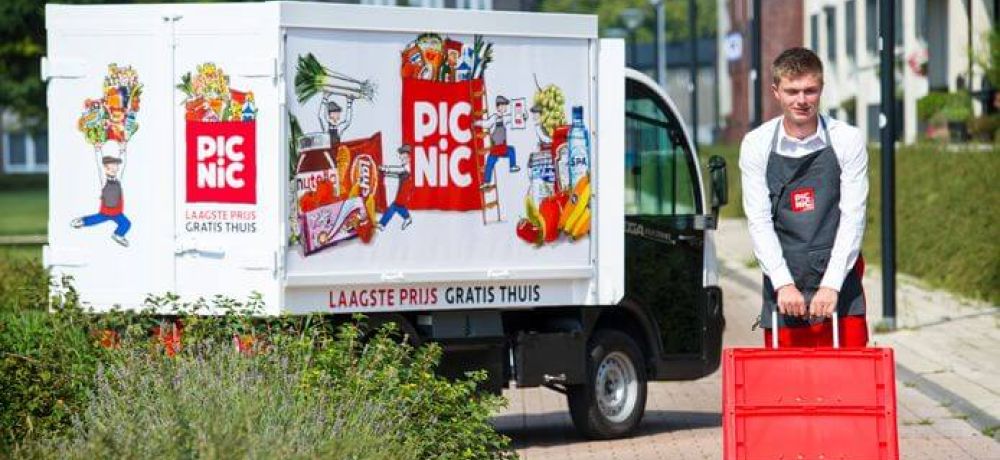
Customer experience: the future of supermarkets
What defines buying behavior? Behavioral psychology and neuroscience explain quite a lot. Brain & Behaviour offers insights into the shaping of consumer behavior. In essence, marketers apply practical psychological insights. How does this work in the recent rise of the online supermarket industry? How can you improve the customer experience? And how do marketers adapt?
Supermarkets are changing, and the playing field of marketing are changing along with it. The focus is shifting from product to consumer, from offline to online. But most importantly, an automatic routine is turning into a personalised experience. Psychology will all play a more significant part in this process than ever before.

The rise of the online supermarket
A couple of years ago, a new player entered the field: the online supermarket. Both mature, well-known names like Jumbo & Albert Heijn and new companies like Picnic and Crisp rose to the stage. Online supermarkets are revolutionary in many aspects. For starters, they do not have to finance and maintain expensive offline stores.
That enables them to focus their attention mainly on aspects like durability, delivery service, and customer experience. Considering the enormous rise in demand for online grocery shopping, there are long customer waiting lists for these new companies. Undoubtedly, online supermarkets are an untapped market.
From product to the consumer
The shift from offline shopping to online shopping is just one aspect of this transition. A just as remarkable change is noticeable in marketing and branding strategies. To illustrate this, we’ll walk through and compare the strategies from conventional supermarkets to online supermarkets.
Big brands identify themselves and their products with the consistent use of specific color patterns. These colors patterns evoke certain feelings and emotions. For instance, research shows that yellow associates firmly with optimism, warmth, and clarity. Especially 12-0752 yellow, or buttercup. Various tests showed that bananas of this particular color sell better than bananas in other shades of yellow.
Due to the combination of applied psychology and GMO, this stack of 12-0752 bananas immediately draws your gaze when you enter a supermarket. And if you are not big on fruits and veggies, the scent of freshly baked bread will put you in a good mood too.
A profitable customer is one that keeps returning but also one that sticks around as long as possible. Supermarkets use, for example, tactical in-store designs to achieve this.
These marketing strategies do not survive the transition to online grocery shopping very well. However, the strategic use of colors do. In online supermarkets’ web-design color psychology is essential for brand imaging and sales. Furthermore, product photography has become more crucial than ever. Smart use of color contrasts combined with quality imagery assures a picture of the product to be as attractive as possible.
From automatic routine to personalised experience
We’ve explained in our article about system 1 and system 2 on our website’s blog that system 1 makes impulsive, quick, and emotional decisions. System 2 tries to keep up with rational and analytical reasoning.
Before the growing awareness for food and health was as common as today, grocery shopping was mostly a system 1 activity. Grab what you need and get out of the shop. Supermarkets want to make sure everyone will find a product that fulfils their needs. Therefore they would stack their aisles with an enormous variety of products. Nowadays, the priorities are into personal preferences and quality, instead of a fast shopping and decision-making pace. Too much variation and choices can cause a paradox of choice.
This paradox is a psychological phenomenon that’s very likely to backfire. Nobody likes losing. If you choose option A, you will lose option B. The search for the right product in an assortment of 26 varieties could cause mental exhaustion. Your customers are left reluctant to buy anything at all! After all, we’re losing option B–Z when choosing option A.
By keeping grocery shopping as easy and comfortable as possible, it remains a system 1 task. Consumers do not want to stand in line at the check-out or drag heavy grocery bags along anymore. Having made a choice to do online shopping, they expect an optimal customer and delivery service and user comfort. The activity of shopping should take as little mental energy as possible. Online and offline supermarkets aim to keep decision-making in system 1.
The consumer has become so much more aware of what they buy and eat. Accordingly, it can be said that the analytical role of system 2 plays a more critical role in the transition to online grocery shopping.
Personalised experience
The ultimate winner in the current economy is the customer. Not the corporations. For this reason, everyone is fighting for the customer’s attention. Tom Peeters (Co-founder of Crips) defines a way to stay on your feet in this fight for customer’s attention. You need to create an optimal customer experience behind your product.
Furthermore, by observing their customers’ online buying behavior and previous purchases, digital supermarkets can suggest their customers an individual and personalised selection of products. Doing so, the shopping experience will become even more comfortable.
A customer that – for example – orders diapers a lot, is likely to be recommended baby food and Sudocrem. As time passes and the customer has no need for diapers anymore, data analyses enable new suggestions for products the customer may need now, such as child-friendly toothpaste. This form of targeting offers a significant advantage in competition with conventional supermarkets.
Planning customer experience
Meeting consumer demands in this fast growing business requires continuously testing. According to Daniel Gebler (CTO of Picnic), it is a must to have multiple teams with separate responsibilities; one team that is responsible for creating and evaluating experiments, and another tech team that builds a scalable platform and infrastructure to run these experiments. The golden metric in this process is the NPS (net promoter score). This score indicates the customer loyalty continuously monitored by the customer success team.
Planning and preparation form an essential part of all business activities. The demand for online grocery shopping is high. Tons of people are lining up and awaiting their turn. Of course digitally, not literally. Customers that queue to use your service may sound like a dream. Keeping your operations scalable under such circumstances requires exact planning.
To realise that, a team of marketers and growth-hackers, devoted to capacity planning, runs tests continuously. With these, they aim to predict how to evolve business operations for an x-percentage of growth. This way, the optimal amounts of new customers can be acquired to meet the customers’ expectations.
Quality is key
Quality-driven marketing has become a large part of the customer experience. It has become clear that consumers are very aware of the health-related aspects of what they buy and eat. The quality is what counts. Crisp, for example, offers products from regional suppliers that are in-season. Additionally, they do all product photography in-house, to give the products a distinct and organic look.
In the current environment, marketing, and product strategy are not about groceries alone. It’s about the story behind the different products combined with a focus on high-quality customer experience. Ultimately this creates an individual experience for each customer. It is clear that the online supermarkets have a huge advantage here.
Top-of-mind, top of market
Albert Heijn and Jumbo have shops on every other corner of the street. Because everybody sees the shops a lot, Albert Heijn and Jumbo quickly pop up in your mind thinking about grocery shopping. Online supermarkets do not have this opportunity to stay on top of the customer’s mind. But there are many different ways to position yourself in the spirit of your customer! Digital alternatives raise customer awareness by in-app invite-a-friend functions. By gifting friends a free product, brand awareness spreads like wildfire.
Frequent customers receive small promotional gifts like branded food-related products. These gifts make sure the online supermarket stays on top of their mind. It creates an association between the online supermarket and grocery shopping. This association enables customers to quickly and prominently recall the brand in grocery shopping situations.
A leading role for psychology
All concepts, tactics, and strategies of marketing are becoming more customer-centric. Conventional (super)marketing revolved around pushing as many products out as possible. But the key to success seems to have shifted to quality and perfect customer service. The creation of personalised customer experiences and personalised offers play a leading role in (super)marketing nowadays.
Behavioral psychology is fundamental in understanding, guiding, and persuading consumers to engage. The understanding of your customer’s needs and buying behavior is essential to create a personalised customer experience. That will lead to more loyal and content customers.
Supermarkets and (super)marketing are changing. The point of focus has shifted; from product to the customer, from offline to online, and from a mindless routine activity to a tailored personal experience. And psychology will play a more prominent role than ever before.
If you want to learn more about behavioral insights, read our blog or watch 100+ videos on our YouTube channel!
About Neurofied
Neurofied is a behavioral science company specialized in training, consulting, and change management. We help organizations drive evidence-based and human-centric change with insights and interventions from behavioral psychology and neuroscience. Consider us your behavioral business partner who helps you build behavioral change capabilities internally.
Since 2018, we have trained thousands of professionals and worked with over 100 management, HR, growth, and innovation teams of organizations such as Johnson & Johnson, KPMG, Deloitte, Novo Nordisk, ABN AMRO, and the Dutch government. We are also frequent speakers at universities and conferences.
Our mission is to democratize the value of behavioral science for teams and organizations. If you see any opportunities to collaborate, please contact us here.
